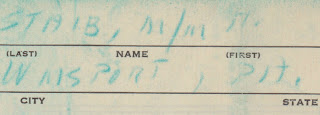Here are two undated postcards of the Olympic-size outdoor swimming pool at Buck Hill Falls, a resort spot in northeastern Pennsylvania.
The top one is a hand-colored postcard published by "The Collotype Co., Elizabeth, N.J., and N.Y." It describes Buck Hill Falls as "a popular fun center."
The bottom postcard also describes Buck Hill Falls as a "popular fun center" -- that must have been the key advertising phrase -- and was published by The Inn at Buck Hill Falls.
On the Buck Hills Falls website, the community is described as still "going strong" 110 years after its earliest development:1
"It's just a step from the turmoil of urban business life to the serenity of ancient woods, streamside glens and the charming tranquility of yesteryear's life-style. Nestled in its 4,500 acres of northeastern Pennsylvania, Buck Hill Falls is only a two-hour drive from Philadelphia or New York City. But it is a world away from either city. ... Summer-stock theater, restaurants, andIn 1908, the first swimming pool was opened at Buck Hill Falls. In 1936, the resort was ahead of its time with the opening of an outdoor, heated Olympic-sized swimming pool. (That's likely the pool pictured in today's two postcards.)
shopping are all nearby, but most Buck Hillers are happy to spend most of their time enjoying the glorious woods, the plunging streams and falls, and the superior sports facilities of their own community. Today, just as they did over a century ago, the Buck Hill Falls residents pride themselves on fostering family traditions and closeness. Whether they are full-time residents or use their homes for weekend and vacation getaways, the owners still enjoy and value the simple life first envisioned by Buck Hill Falls' founders over a century ago."
The current outdoor pool is only open from mid-June through Labor Day weekend. Swim lessons, a swim team and a summer swim meet schedule are offered.
One part of the resort that has not stood the test of time, however, is The Inn at Buck Hill Falls, which originally opened in 1901. From its 18-room beginning, it eventually expanded to a complex with more than 400 rooms. According to this Buck Hills Falls history website:
"In 1958 the dining room at Buck Hill began serving liquor and four years later they opened a cocktail lounge. Many believe this was a turning point in the resort. The Inn did continue to prosper for a few more years and another addition to the Inn was built in 1964 with the construction of the west wing. Architecturally, the building was not compatible with the Mission Revival Style of the existing building. Profits were in decline by the mid 1960’s and early 1970’s. In the late 1970’s the Board of Directors of the Buck Hill Falls Company decided it would be in the best interests of the stockholders to sell off the Inn with 134 acres but continue to own and maintain all the amenities [including the golf course, pool, tennis courts, hiking trails, etc.]."The Inn at Buck Hill Falls officially closed in 1991. The property is available for subdivision and development from Falls Road Funding, the current owner, as detailed on this website.
Unfortunately, the storied inn's current "claim to fame" is that it's haunted, possessed and evil, having been the spot of scores of murders -- certainly a bunch of bunk and malarkey.2 The site is also subjected regularly to trespassers and would-be ghost hunters, hoping to secure their fame with a YouTube sensation.
If you are curious about what The Inn at Buck Hill Falls looks like now -- minus the "ghosts and satanic forces" -- I highly recommend this Spirits of the Abandoned photo gallery by Susan Tatterson. Even in the building's decay, there is sad beauty conveyed in Tatterson's images.
Footnotes
1. That earliest development was spurred by Samuel Griscom. According to this Buck Hills Falls website: "It took less than a year from the time Philadelphia Quaker Samuel Griscom inspected the wild land he had just inherited to the development and sale, in 1901, of the first 43 lots in Buck Hill Falls. Griscom had sold the land to his friend Howard M. Jenkins, editor of a Philadelphia newspaper, and, a group of prosperous Philadelphians, for their families and others." The separate BuckHillFalls.org website also has some good history, background information and old photos.
2. This page on Pennsylvania Haunts & History details (and does nothing to dispel) all of the exaggerations that lead to teens with camcorders and reality-show hosts trooping around the site.































